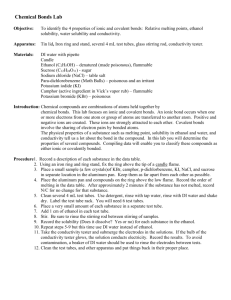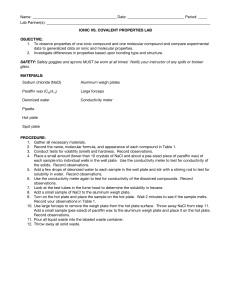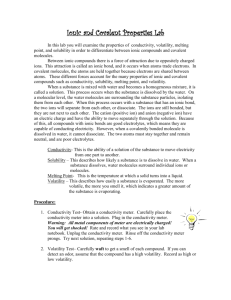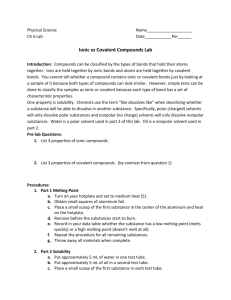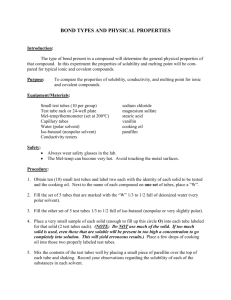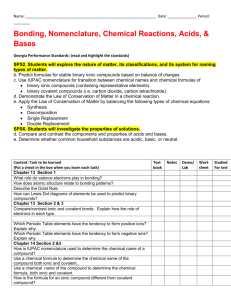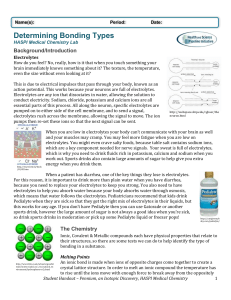Lab * Identifying Chemical Bonds
advertisement
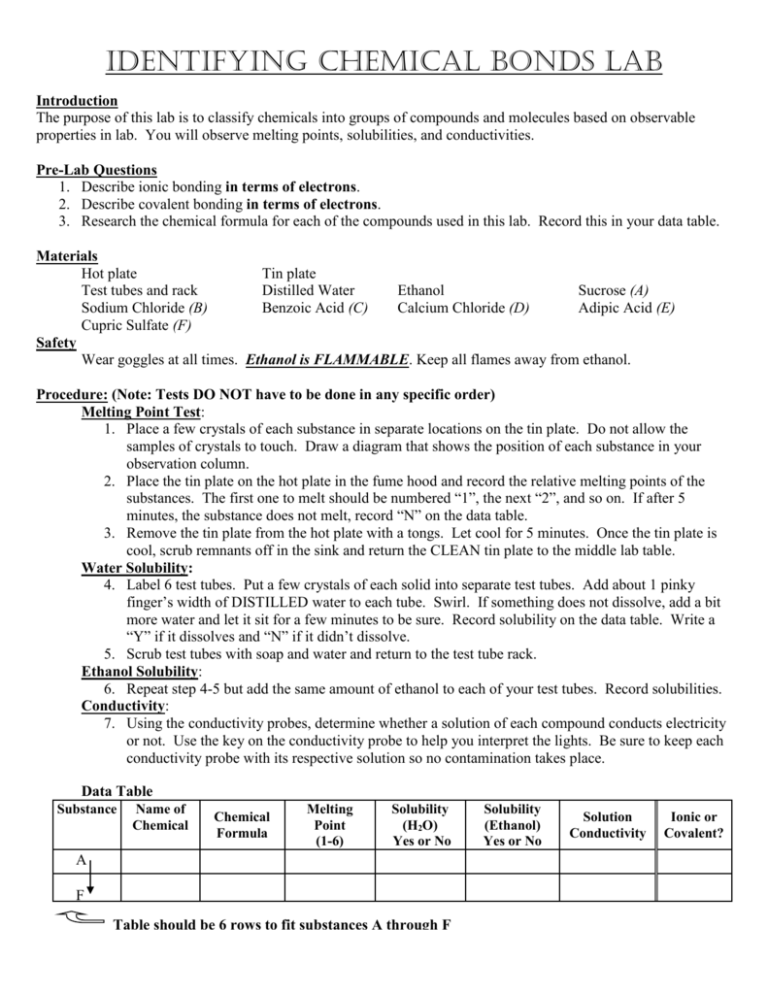
Identifying Chemical Bonds Lab Introduction The purpose of this lab is to classify chemicals into groups of compounds and molecules based on observable properties in lab. You will observe melting points, solubilities, and conductivities. Pre-Lab Questions 1. Describe ionic bonding in terms of electrons. 2. Describe covalent bonding in terms of electrons. 3. Research the chemical formula for each of the compounds used in this lab. Record this in your data table. Materials Hot plate Tin plate Test tubes and rack Distilled Water Ethanol Sucrose (A) Sodium Chloride (B) Benzoic Acid (C) Calcium Chloride (D) Adipic Acid (E) Cupric Sulfate (F) Safety Wear goggles at all times. Ethanol is FLAMMABLE. Keep all flames away from ethanol. Procedure: (Note: Tests DO NOT have to be done in any specific order) Melting Point Test: 1. Place a few crystals of each substance in separate locations on the tin plate. Do not allow the samples of crystals to touch. Draw a diagram that shows the position of each substance in your observation column. 2. Place the tin plate on the hot plate in the fume hood and record the relative melting points of the substances. The first one to melt should be numbered “1”, the next “2”, and so on. If after 5 minutes, the substance does not melt, record “N” on the data table. 3. Remove the tin plate from the hot plate with a tongs. Let cool for 5 minutes. Once the tin plate is cool, scrub remnants off in the sink and return the CLEAN tin plate to the middle lab table. Water Solubility: 4. Label 6 test tubes. Put a few crystals of each solid into separate test tubes. Add about 1 pinky finger’s width of DISTILLED water to each tube. Swirl. If something does not dissolve, add a bit more water and let it sit for a few minutes to be sure. Record solubility on the data table. Write a “Y” if it dissolves and “N” if it didn’t dissolve. 5. Scrub test tubes with soap and water and return to the test tube rack. Ethanol Solubility: 6. Repeat step 4-5 but add the same amount of ethanol to each of your test tubes. Record solubilities. Conductivity: 7. Using the conductivity probes, determine whether a solution of each compound conducts electricity or not. Use the key on the conductivity probe to help you interpret the lights. Be sure to keep each conductivity probe with its respective solution so no contamination takes place. Data Table Substance Name of Chemical Chemical Formula Melting Point (1-6) Solubility (H2O) Yes or No A F Table should be 6 rows to fit substances A through F Solubility (Ethanol) Yes or No Solution Conductivity Ionic or Covalent? Post-Lab Questions **Using the results from your experiment, determine whether each compound has ionic or covalent bonds. RECORD YOUR FINDINGS IN THE LAST COLUMN OF YOUR DATA TABLE. 1. In this lab, you may have found that you had conflicting data about whether a compound was ionic or covalent. Do you believe that this sort of conflicting data is common for most chemicals, or do you think that the compounds you used are unusual? Explain. 2. What is the relationship between electronegativity and bond type? Put another way, why could we predict whether a compound would be ionic or covalent if given a list of the elements’ electronegativities? 3. How can you predict whether a compound is ionic or covalent simply by looking at its formula? Hint: look at the periodic table and think about the types of atoms involved. 4. Most ionic compounds don’t burn. However, sodium citrate (Na3C6H5O7) does. Give a possible explanation for sodium citrate’s flammability. 5. Pure water is a covalent compound and doesn’t conduct electricity. With this in mind, explain why you still would electrocute yourself if you took a bath with your hair dryer on, even if you took a bath in perfectly pure distilled water. Don’t forget your Conclusion!!!
